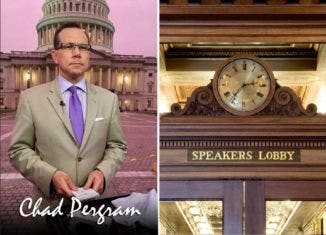Low-Hanging Fruit
The Speakerís Lobby: Low-Hanging Fruit
By: Chad Pergram, FOX News
05 June 2010
I was talking with a friend a few weeks ago outside the Capitol when a police officer approached us. He asked us to move because they had discovered a ďsuspicious vehicleĒ and needed to clear the area.
I immediately presumed the vehicle in question was over on Independence Avenue, the long boulevard that runs between the Capitol and the House office buildings. I then thought the vehicle was at the barricades between the Longworth and the Cannon House Office Buildings.
But it wasnít.
Instead, the suspicious vehicle was at the gate, just feet from the Capitol itself. Police swarmed and created a security perimeter, pushing people back toward the Library of Congress.
We get alerts about suspicious vehicles and suspicious packages all the time on Capitol Hill. A lost tourist from Quebec who only speaks French tries to park on the Capitol grounds. An eighth-grader from Tennessee absent-mindedly leaves his backpack in the Capitol Visitorís Center. Most of these episodes are benign, every-day occurrences.
But this situation seemed a little different.
First, the vehicle was close to the Capitol. Steps from where lawmakers walk when they go to the Capitol for votes and meetings. And a short-distance from where police idle the fleet of dark SUVís that shuttle Congressional leaders around town. Itís rare that police have an issue with a vehicle this close to the Capitol itself. Secondly, authorities began investigating the suspicious vehicle just as Afghan leader Hamid Karzai was arriving to meet with House Speaker Nancy Pelosi (D-CA). And third, this unfolded just days after vendors noticed what turned out to be a car bomb in Times Square.
U.S. Capitol Police cleared the area for a about a half-hour while they inspected the vehicle in question and cut off traffic on Independence Avenue.
But then they gave the all-clear. Hamid Karzai visited the speaker without incident. And life returned to normal on Capitol Hill.
As it turns out, police canine units found something fishy with the vehicle in question. It was driven by a Congressional aide trying to park his SUV on the Capitol plaza. But after a more thorough inspection, police cleared the SUV. There were a few tense moments. However, the episode dissipated.
But it might not have.
I work in the one of the most-dangerous buildings in the world. Itís clear the Capitol is a high-value target. The symbolism of bombing the Capitol would be extraordinary and resonate with terrorists around the globe.
But the unique security posture of the Capitol makes executing a big bombing or a chemical attack a challenge. Which is why the Capitol complex offers something else that appeals to terrorists: low-hanging fruit.
Low-hanging fruit is the stuff thatís easy for a terrorist to take advantage of. A bomb at an obscure entrance to the Rayburn House Office Building parking garage. A suicide bomber in line for the Capitol Visitorís Center. A car packed with explosives that pulls up to unsuspecting cops guarding the north barricade.
It might not be as dramatic as slamming jetliners into skyscrapers or as ingenious as packing your underwear full of explosives. But plucking from the low-hanging fruit could have even more devastating consequences.
Itís all about the opportunity.
And Capitol Hill is loaded with them.
In the summer of 2004, security officials fretted about the potential of attacks at that yearís political conventions or at the World Bank. Immediately, police steeled the Capitol against the threat by erecting jersey barriers around the building and introducing some random searches of vehicles driving into semi-secure areas. I often park on Pennsylvania Avenue in front of the Capitol. I was suffering from back trouble at the time which made walking difficult. So Iíd periodically catch a Senate Sergeant-at-Arms van that would cruise around the various parking locations and drop off passengers near the Capitol.
On the first day, I was shocked at what I discovered. The white van approached the Capitol and was waved past the security barricades by police officers. The officers seemed to recognize the driver since he made multiple passes each day. Plus the van bore a U.S. Senate logo on the door.
But a light bulb went off above my head.
If someone wanted to set off a bomb, you could hijack the van, pass the security barricade and then drive up the Capitol steps.
Low-hanging fruit.
Thereís always a way.
Other locations around the Capitol scare me. Capitol Hill regulars pass through security checkpoints on a daily basis. Itís like a scaled-down version of filtering through airport screening. You show your ID. Empty your pockets of phones and keys. Sometimes you have to shed your belt or shoes. You slide laptops and briefcases onto a conveyer belt which then pulls your items through an X-ray machine.
But almost all of this is done INSIDE Congressional buildings, whether it be the Capitol or an entrance to the Dirksen Senate Office Building. A determined terrorist wouldnít even have to skate past security. He could just wait in line alongside the rest of the staff and tourists trying to enter the buildings. In fact thereís one entrance that worries me the most. Thereís a doorway off the Russell Senate Park that takes you into the Russell Senate Office Building. People walk a good 40 feet inside that structure before they even reach the security checkpoint.
More than one lawmaker has confided in me that those entrances worry them, too. One senior senator told me he feared car bombs so much that he wouldnít take an office on the Constitution Avenue sides of the Russell, Dirksen or Hart Senate Office Buildings.
That senatorís office is now burrowed deep within Hart.
Some lawmakers even fear for their safety inside the House chamber. Which is why Rep. Dan Burton (R-IN) has floated an idea that would make watching House sessions similar to viewing an NHL game. Burtonís not suggesting the political fighting on the House floor resembles the scraps that unfold on the ice between a couple of hockey enforcers. And he doesnít want to change the icing rule. Instead, Burton proposes installing a stretch of see-through plexi-glass in the House viewing gallery. The public can still watch the action on the floor. But theyíre separated by glass just like they would be if watching a game at Madison Square Garden.
Members of the public who come to the Capitol to view House sessions are screened to get into the building and then again before entering the chamber. But as Omar Farouk Abdulmutallab demonstrated when he tried to blow up a jet above Detroit on Christmas Day, if itís possible to smuggle explosives aboard an airliner, it could be possible to smuggle something into the House chamber.
Again, taking advantage of low-hanging fruit.
Of course, Burtonís idea might protect Members of Congress on the floor below. But it would still expose the public and press corps, watching the proceedings from high above.
The Capitolís low-hanging fruit is exposed from time-to-time.
In July, 1998, Russell Weston Jr. exposed low-hanging fruit when he charged through the Memorial Door of the Capitol, killing Officer Jacob Chestnut and Detective John Gibson. Chestnut worked the door solo. Gibson was well inside the building. Since then, police require at least two officers at each entrance now.
During the construction of the Capitol Visitorís Center, Carlos Green rammed his car through the work area. He then sprinted up the east steps of the Capitol and dashed through an unsecured door. Green made it into the Rotunda and found his way to the basement of the Capitol before a worker in the flag office tackled him. Police had left the door at the top of the steps unguarded because it was only accessible to construction workers toiling at the visitorís center.
And those who crash their cars into the construction site and then run into the building.
U.S. Capitol Police and other security forces have a challenging job. They do a yeomanís job protecting the thousands of people who work and visit the Capitol complex each day. But no matter how good they are, there will always be low-hanging fruit.
Detonating a thermonuclear weapon in Midtown Manhattan may kill a lot more people. And piloting a plane into Big Ben in London may be more cinematic.
But the purpose of terrorism is to inflict terror.
And that goal is a whole lot easier if you pick from the low-hanging fruit.
-†††††††† Chad Pergram covers Congress for FOX News. Heís won an Edward R. Murrow Award, the Joan Barone Award and a National Headliner Award for his reporting on Capitol Hill.
-†††††††† The Speakerís Lobby refers to a long, ornate corridor that runs behind the dais in the House chamber. Lawmakers, aides and journalists often confer there during votes.

